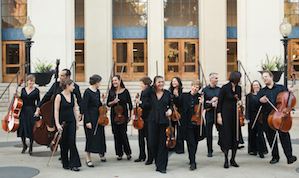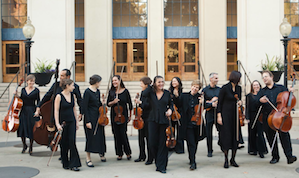
The New Century Chamber Orchestra presented two composer pairs in a mentor-mentee relationship on Wednesday at the Mountain View Center for the Performing Arts. Juxtaposing Peter Ilyich Tchaikovsky with Anton Arensky, plus Clarice Assad with Michael Daugherty, highlighted how profoundly context and education both shape a composer’s voice.
Principal cellist Susan Babini was featured in Tchaikovsky’s Andante Cantabile. Babini played with silky-smooth bow strokes and finely nuanced gradients on each tapered phrase. The orchestra accompaniment was played on tip-toes, allowing Babini to utter her simple, beautiful melody softly, without having to wail. Sometimes strings sound the best in their mezzo-piano range. Too often we hear instruments beat and scratched, in an attempt to claw through an ensemble to make sure that they are heard. This performance, by contrast, was inward, intimate music-making.
Arensky’s Variations picked up in the identical mood as the Tchaikovsky, sometimes indulging in that same brooding Russian folk-song world, and at other times engaging in showy pyrotechnics around the theme. Arensky imitates the elder Tchaikovsky well — maybe too well to notice a difference?
Daugherty addresses this question in his program note, recalling how his teacher György Ligeti would scold pupils for imitating their master rather than finding a unique voice. Nowadays the range of voices available to a composer is much wider. Daugherty’s former student Clarice Assad doesn’t necessarily sound like the former, though their approaches definitely coincide — resulting in passionately honest music that is intentionally not self-aware but is equally comfortable with abstract tone worlds as well as Western triadic harmony.
Assad’s Dreamscapes pits a solo violin (as the aware “self”) against an orchestral accompaniment (as the unaware subconscious). The work starts peacefully, with pitches sliding slowly, like heavy eyelids. Once REM sleep takes over, so to speak, a nightmare ensues. The orchestra and violin work up a frenzy with which a therapist could have a field day. The texture occasionally falls back into the tired dreamy world, but the nightmare rages on, suddenly cutting off on a foot stomp by Nadja Salerno-Sonnenberg, NCCO’s music director. The piece could have ended there, but after a five-second grand pause, the languid texture from the beginning returns. Coming after the nightmare music, the reprise sounded a little more creepy than peaceful.
Fallingwater works both as an abstract work and as an allusion to the iconic nature and grandeur of Wright’s architectural voice.
Michael Daugherty is this season’s featured composer; the NCCO’s September set concentrated on his music. This provided a fine opportunity for audiences and performers alike to actually develop a relationship with a specific composer’s music, as opposed to hearing (or playing) a premiere by someone they’ve never heard of, only to never hear from them or play them again.
Dreamscapes was recently performed by Salerno-Sonnenberg and the orchestra. That makes fine sense: Why learn such difficult music, one wonders, merely to move on and never recycle? The two concertos were performed with a passion that only comes from a deep familiarity.
Fallingwater was inspired by Frank Lloyd Wright’s architecture, with each movement corresponding to one of his buildings. Daugherty often alludes to other artists and ideas in his titles, but beyond triggering the composer’s imagination these might as well be PR gimmicks. The audience has the choice of whether to imagine how the music fits into the image conjured by the descriptive title, or to listen to it plainly as a concerto for strings and orchestra. This is what makes music different from painting or architecture — music doesn’t easily lend itself to such specific analogies.
Fallingwater works both as an abstract work and as an allusion to the iconic nature and grandeur of Wright’s architectural voice. Any number of metaphors could be substituted for this amazing, beautiful, and passionate concerto. It follows the tried and true form of fast-scherzo-slow-fast, though here the scherzo was more frightening than funny. The slow movement, “Prairie Psalm,” had the openness and seemingly endless expanse of the Midwest. As always, Salerno-Sonnenberg played with gripping intensity and thrilling virtuosity, especially in the “Ahead of the Curve” movement, inspired by New York City’s Guggenheim Museum, in which the violin line always runs ahead of the orchestra, beating it to every turn.
Nadja Salerno-Sonnenberg is an inspiring leader. The musicians comprising the NCCO are a mix of top players from all around the country, as well as a selection of elite string players among the Bay Area’s “Freeway Philharmonic.” These hardworking musicians give their director and lead player that extra effort that they may not necessarily be moved to give a conductor who is not actually playing with them. Fellow string players can’t hide anything from a legendary violinist in their midst, such as her, so they have to be on their top game when playing with the NCCO. Salerno-Sonnenberg always has them paying attention, with a tense connection that baton conductors seldom achieve. While she never fails to be feisty and energetic, her cues, to my eye, often seem overly demonstrative. (Is a big “snort breath” and a huge lunge, for example, really needed to cue even the delicate phrases?)
On a more somber note, to pay tribute to JFK on the 50th anniversary of his assassination, the orchestra played Samuel Jones’ lugubrious Elegy for Strings to open the concert.

